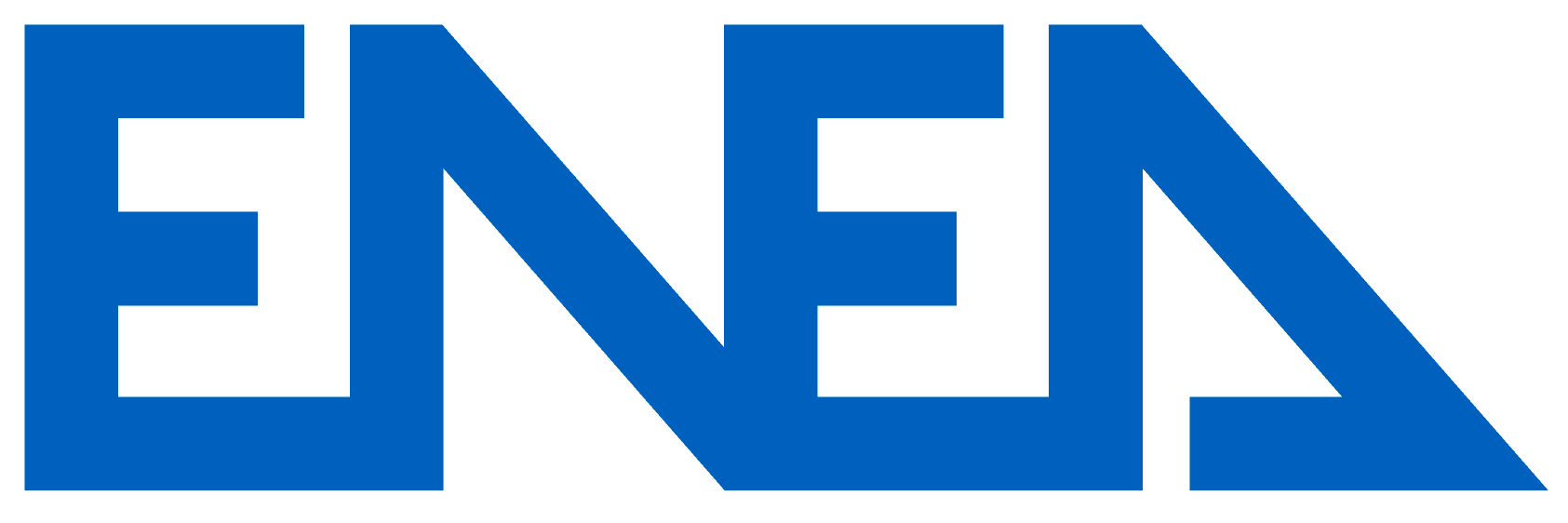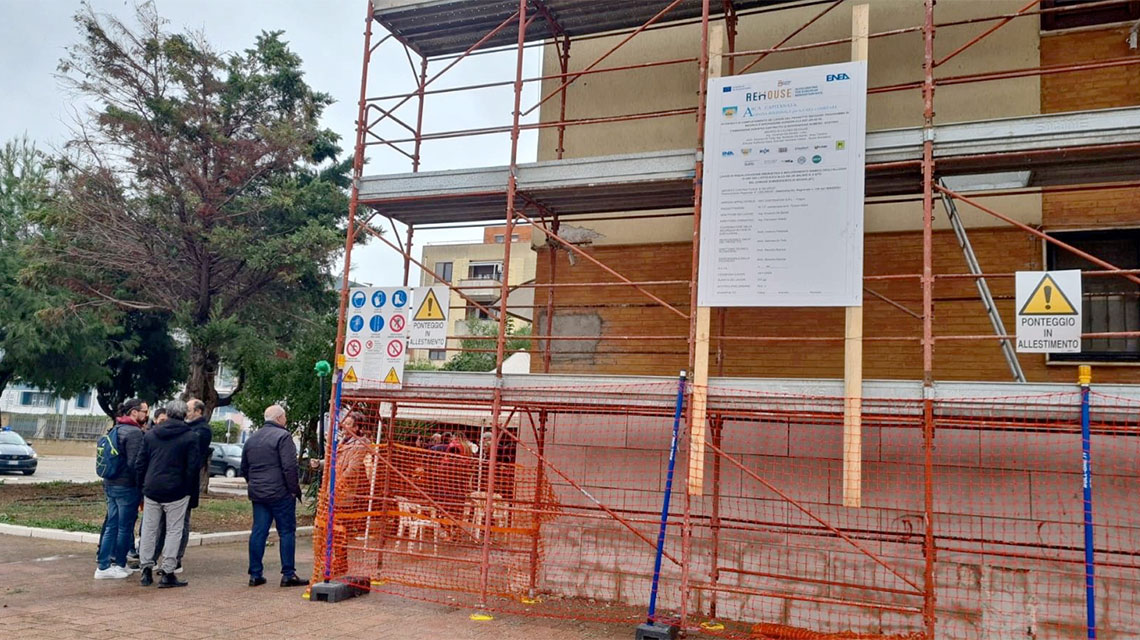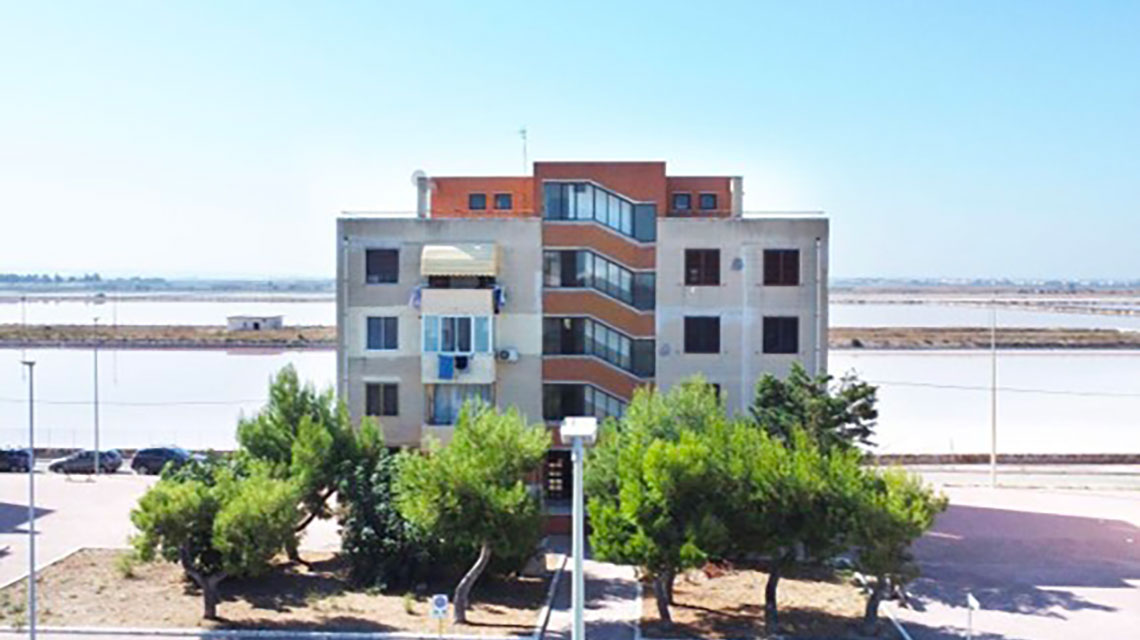Italian National Agency for New Technologies, Energy and Sustainable Economic Development

Energy: Renovation of a social housing building begins in Apulia
The energy requalification of a social housing building in the Apulian municipality of Margherita di Savoia [1], has started. The site was chosen as an Italian pilot project thanks to the European project REHOUSE comprising ENEA, the University of Basilicata, Rina Consulting, TERA, Steel tech, R.I., Pedone Working, SUPSI and Sunage in Italy.
“The main objective of the project is to develop and apply eight different innovative and promising technologies in four pilot buildings in Greece, Italy, Hungary and France. Each case study represents a type of building (social housing buildings and student dormitories) ina specific climate area, with different characteristics and types of dwellers. But the great challenge will be to boost tenants engagement in innovative technologies and pave the way for a real cultural change in energy use, adopting a people-centered approach”, pointed out Monica Misceo of the Laboratory of Projects and Good Practices for the Energy Requalification of Buildings and responsible for the project for ENEA.
“it’s an innovative experiment” Misceo continued “that combines technology and social cooperation for the first time: in fact, we have shared every part of the energy efficiency project with the tenants from the beginning, who have thus also been able to acquire greater awareness of the correct use of energy and better management of the systems.”
The renovation works will contribute to reducING energy consumption and CO2 emissions of the pilot building and improve the living comfort and living conditions of the tenants. As concerns the building in Apulia, the activities will involve the structural consolidation of two internal pillars, a centralized system for the production of hot water and cooling, replacement of the window frames, creation of an envelope that incorporates natural insulating materials based on hemp and a photovoltaic facade (enabling the generation of 16,000 kW/year of electricity from renewable sources and guaranteeing good thermal insulation [2]).
Plus, a street art project and the redevelopment of the external spaces are planned, to encourage aggregation and social cohesion in the neighborhood.
"The energy requalification of public social housing is a crucial challenge for a more sustainable and inclusive society. Our 'experiment' could provide a good level of replicability to be extended to other social housing buildings to improve the living comfort of the most vulnerable families, alleviate energy poverty and combat the growing phenomenon of housing degradation, redeveloping cities or entire neighborhoods", said Monica Misceo.
For the Italian case study, ENEA researchers have developed an integrated diagnosis - energy, structural and social - to optimize the instrumental and diagnostic tests in order to limit the disturbance caused to the tenants and, at the same time, provide 'pills' of knowledge on the technologies they will use at the completion of the intervention.
The building owned by ARCA Capitanata dates back to 1986, consists of four floors for a total of 880 m2 and currently houses 20 people, mostly elderly. Built with a reinforced concrete frame, it shows heat loss and housing discomfort due to high temperatures in summer, inadequate natural ventilation, obsolete systems and architectural barriers. Located in a peripheral area of the city, it is part of a group of similar units, all characterized by structural degradation issues (40% of the social housing stock in the area is over 40 years old, with high energy consumption and greenhouse gas emissions) and social vulnerability due to economic hardship, health issues, high school dropout rates, loneliness among the elderly and psychomotor disabilities. Furthermore, the area is classified as medium-high seismic risk (zone 2).
Before starting the works, an interdisciplinary team of Italian partners of REHOUSE [3] presented and discussed with the tenants the technical solutions to improve the living conditions in the building. “During these meetings we highlighted the motivations behind the design choices, focusing on how the building would change thanks to the interventions and what impact this change would have on the lives of the residents, followed by the color of the building, the mosaic of the north facade, the street furniture of the outdoor spaces. Participants’ observations were collected to enhance acceptance by the residents”, said Misceo.
ENEA has also organized a simulation game for the tenants called ENZEB [4], with the purpose of reaching the maximum energy efficiency to appreciate tangibly the change expected from the building interventions and the importance of everyday habits in the use of energy.
Notes
[1] The building is located in Margherita di Savoia, a coastal municipality on the Adriatic in the Apulia region (Italy), in the Barletta-Andria-Trani area, surrounded by a rich ecosystem characterized by the Margherita di Savoia Salt Mines, a 20 km long area existing since the 3rd century BC and part of the territory (a pre-Roman center). These Salt Mines were named after the first queen of Italy in 1879 and are the largest in Europe and the second in the world.
[2] Overall thermal transmittance of the perimeter wall plastered area TSA+PV, U=0.26W/mqK.
[3] Team composed of ENEA technicians, specialists appointed by ARCA Capitanata, a representative of the Apulia Region and the Bibbò technical studio.
[4] The game period covers five years, corresponding to approximately one hour of play, during which real circumstances are reproduced through concrete simulations to understand the decision-making process before the energy requalification of a building. The game kit includes a board, intervention cards, opportunities to use and unexpected obstacles to overcome. Participants can choose between several scenarios, like buildings constructed in different periods that require renovation; two types of interventions to implement with their respective impacts in terms of consumption, CO2 emissions, value of the property and living comfort; the costs to be sustained and the revenues obtained in terms of bonuses, depending on the interventions chosen; financial resources, represented by EnzEuro banknotes distributed differently among the participating groups; unforeseen events and opportunities; a five-year time frame within which to choose the technological and behavioral interventions to implement. The decision-making process led to a choice of less invasive interventions although equally effective in terms of impacts, so much so that, in the five years available, the group exceeded the target levels set for the condominium, reaching very low levels of consumption and CO2 emissions.


